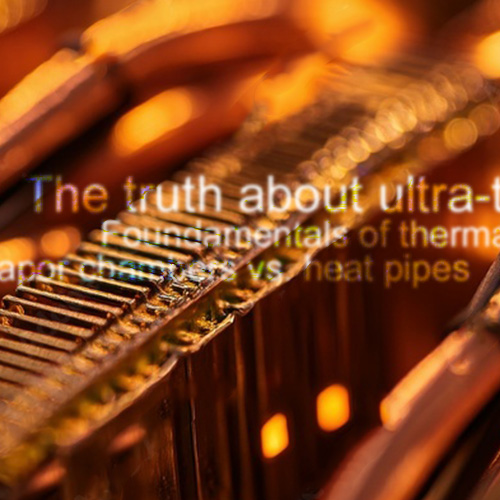This article compares heat sink design for moderately high-power density applications (100 W/cm²), evaluating five designs in terms of performance, weight, and cost. These include solid metal base solutions (aluminum and copper), embedded heat pipe configurations, and a vapor chamber base design. Each was modeled via CFD and analyzed for thermal resistance, weight, and relative cost.
5 Different Heat Sink Designs
This heat sink design comparison evaluates:
- Aluminum base (6mm) heat sink
- Copper base (6mm) heat sink
- Heat pipe with aluminum base (6mm) heat sink
- Heat pipe with copper base (6mm) heat sink
- Vapor chamber base (4mm) heat sink
If you want more general heat sink design guidance, please see Heat Sink Design Fundamentals.
Design Parameters
These values serve as a controlled basis for this heat sink design comparison, ensuring consistency across all models.
- Heat Source: 10×10 mm generating 100 W (100 W/cm²)
- Tcase Max: 80 °C
- Max Ambient: 45 °C
- Thermal Budget: 35 °C (80 – 45)
- Target thermal resistance: 0.35 °C/W
- TIM: k = 3 W/(m·K)
- Aluminum Fin Pack: 150 x 99 x 30 mm
- Fin Thickness: 0.3 mm
- Fin Gap: 1.2 mm
- Airflow: 50 CFM
Results
Solid Metal Base Design Options (Designs #1 and #2)
A key consideration in any heat sink design comparison is how each solution performs relative to the allowable thermal resistance budget. With a 35 °C thermal delta (Tcase Max – Max Ambient), both the aluminum and copper base designs exceed this limit.
While cost-effective, neither solid metal heat sink meets the 0.35 °C/W requirement. The aluminum version falls well short, and although the copper version performs better thermally, it comes with a substantial weight penalty—more than doubling from 500 g to 1,055 g. This is a concern for systems subject to shock, vibration, or portability constraints.
For reference, a 12mm copper base can achieve a ΔT of 34.4 °C, but the weight exceeds 1,800 g, making it impractical for many high-performance or ruggedized applications.
Embedded Heat Pipes in Solid Metal Bases (Designs #3 and #4)
In these configurations, two 6mm copper/water heat pipes are embedded into the aluminum or copper base, then flattened to 3mm and bent to fit. The base beneath the heat source is machined to 0.025 mm/cm flatness to ensure proper thermal interface contact.
The result is a significant performance improvement in this heat sink design comparison. The aluminum version shows a 26 °C reduction in delta-T, while the copper version improves by roughly 8 °C. Both comfortably meet the thermal budget. However, the copper model again doubles in weight compared to its aluminum counterpart, and both configurations increase cost relative to their solid metal equivalents.
Vapor Chamber Base (Design #5)
As expected, the vapor chamber base outperforms the others in terms of thermal resistance, with a delta-T of 26.0 °C; 5 °C cooler than the next best option. The 4mm thickness allows a 2mm height reduction in the base itself. If the saved space isn’t critical, it can be reallocated to the fin section, improving airflow exposure and further reducing resistance.\
Summary
This heat sink design comparison highlights how material choice and two-phase integration can dramatically affect thermal performance. While solid metal heat sinks remain viable for lower-performance needs, heat pipes and vapor chambers offer superior thermal behavior, especially for high heat flux conditions. In upcoming parts, we’ll expand on design impacts under varying airflow rates and spatial constraints.




